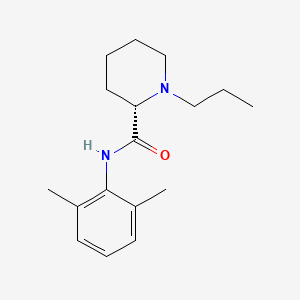D0107 | Ropivacaine
N
N01BB09 Ropivacaine
[N01BB] Amides
[N01B] ANESTHETICS, LOCAL
[N01] ANESTHETICS
[N] Nervous system
| Pictogram | Signal | Statements | Precautionary Statement Codes |
|---|---|---|---|
 |
Warning |
Aggregated GHS information provided by 13 companies from 4 notifications to the ECHA C&L Inventory. Each notification may be associated with multiple companies. H302 (92.31%): Harmful if swallowed [Warning Acute toxicity, oral] H315 (76.92%): Causes skin irritation [Warning Skin corrosion/irritation] H319 (76.92%): Causes serious eye irritation [Warning Serious eye damage/eye irritation] H332 (69.23%): Harmful if inhaled [Warning Acute toxicity, inhalation] H412 (84.62%): Harmful to aquatic life with long lasting effects [Hazardous to the aquatic environment, long-term hazard] Information may vary between notifications depending on impurities, additives, and other factors. The percentage value in parenthesis indicates the notified classification ratio from companies that provide hazard codes. Only hazard codes with percentage values above 10% are shown. |
P261, P264, P270, P271, P273, P280, P301+P312, P302+P352, P304+P312, P304+P340, P305+P351+P338, P312, P321, P330, P332+P313, P337+P313, P362, and P501; (The corresponding statement to each P-code can be found at the GHS Classification page.) |
  |
Danger |
Aggregated GHS information provided by 49 companies from 7 notifications to the ECHA C&L Inventory. Each notification may be associated with multiple companies. H302 (12.24%): Harmful if swallowed [Warning Acute toxicity, oral] H318 (81.63%): Causes serious eye damage [Danger Serious eye damage/eye irritation] H412 (12.24%): Harmful to aquatic life with long lasting effects [Hazardous to the aquatic environment, long-term hazard] Information may vary between notifications depending on impurities, additives, and other factors. The percentage value in parenthesis indicates the notified classification ratio from companies that provide hazard codes. Only hazard codes with percentage values above 10% are shown. |
P264, P270, P273, P280, P301+P312, P305+P351+P338, P310, P330, and P501; (The corresponding statement to each P-code can be found at the GHS Classification page.) |
 |
Warning |
Aggregated GHS information provided by 3 companies from 1 notifications to the ECHA C&L Inventory. Each notification may be associated with multiple companies. H302 (100%): Harmful if swallowed [Warning Acute toxicity, oral] H412 (100%): Harmful to aquatic life with long lasting effects [Hazardous to the aquatic environment, long-term hazard] Information may vary between notifications depending on impurities, additives, and other factors. The percentage value in parenthesis indicates the notified classification ratio from companies that provide hazard codes. Only hazard codes with percentage values above 10% are shown. |
P264, P270, P273, P301+P312, P330, and P501; (The corresponding statement to each P-code can be found at the GHS Classification page.) |
| Organism | Test type | Route | Dose (normalized dose) | Effect | Source |
|---|---|---|---|---|---|
| rat | LD50 | parenteral | 56mg/kg (56mg/kg) | Anesthesiology. Vol. 89, Pg. 1199, 1998. | |
| (-)-1-Propyl-2',6'-dimethyl-2-piperidylcarboxyanilid | (-)-1-Propyl-2',6'-pipecoloxylidide | (-)-1-propyl-2',6'-dimethyl-2-piperidylcarboxyanilide |
| (2S)-N-(2,6-dimethylphenyl)-1-propyl-2-piperidinecarboxamide | (2S)-N-(2,6-dimethylphenyl)-1-propyl-piperidine-2-carboxamide | (2S)-N-(2,6-dimethylphenyl)-1-propylpiperidine-2-carboxamide |
| (S)-(-)-1-propyl-2',6'-pipecoloxylidide | (S)-N-(2,6-Dimethylphenyl)-1-propylpiperidine-2-carboxamide | (S)-Ropivacaine |
| 057R954 | 2-Piperidinecarboxamide, N-(2,6-dimethylphenyl)-1-propyl-, (2S)- | 7IO5LYA57N |
| 84057-95-4 | 98717-15-8 | A840710 |
| AB00698466-07 | AB00698466_10 | AK326168 |
| AKOS017343283 | AL-381 | AS-35173 |
| BBL102321 | BIDD:GT0203 | C07532 |
| CHEBI:8890 | CHEMBL1077896 | D08490 |
| DB00296 | DTXSID4040187 | GTPL7602 |
| K500 | L-N-n-propylpipecolic acid-2,6-xylidide | LEA-103 |
| LEA-103 HCl | NCGC00164597-01 | Narop |
| Naropin | Naropin (TN) | Noropine |
| Q-201677 | Q279504 | Ropivacaina |
| Ropivacaina [INN-Spanish] | Ropivacaina [Spanish] | Ropivacaine |
| Ropivacaine (INN) | Ropivacaine [INN:BAN] | Ropivacaine [INN] |
| Ropivacaine base | Ropivacainum | Ropivacainum [INN-Latin] |
| S-Ropivacaine | SC-23114 | SCHEMBL33292 |
| STL556120 | UNII-7IO5LYA57N | ZINC897002 |
| ZKMNUMMKYBVTFN-HNNXBMFYSA-N |
| DrugBank Name | Ropivacaine |
| DrugBank | DB00296 |
| CAS Number | 132112-35-7, 84057-95-4, 98717-15-8 |
| PubChem Compound | 175805 |
| KEGG Compound ID | C07532 |
| KEGG Drug | D08490 |
| PubChem.Substance | 46504712 |
| ChEBI | 8890 |
| PharmGKB | PA451271 |
| ChemSpider | 153165 |
| TTD | DAP001230 |
| Wikipedia | Ropivacaine |
| DPD | 11081 |

